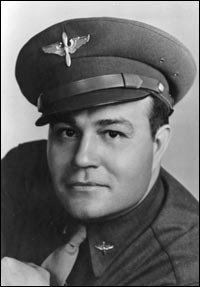|
Acee Blue Eagle (1907-1959) aka Alexander C. McIntosh aka Che Bon Ah Bula
Alexander C. McIntosh and a twin brother (who died four days later) were born August 17, 1907, (also listed as 1907, August 7, 1909, 1911)1
at Hitchita or Anadarko or Wichita Reservation, Oklahoma2 to W. S. and Martha Blue Eagle McIntosh, a Scottish father and Creek-Pawnee mother. Both parents died when he was young, and he lived with his grandparents, who also died during his childhood. W. R. Thompson, of Henryetta, Oklahoma, was appointed his legal guardian.
Alexander C. McIntosh was the grandson of Alexander McIntosh, who was a grandson of Roley Roderick, Chief of the Creeks. Roley was half brother to the famous Chief William McIntosh (c.1775-1825).
Alexander McIntosh, grandfather of Blue Eagle, was a member of the Creek House of Warriors in 1887; an assistant judge of the Muskogee district for three years and in 1898 he was appointed Superintendent of Schools for the Creek Nation by Chief
Isparhacher.
The name, Acee, comes from having been called "Ah Say" since he was a child and reflects the initials of his first and middle name. He took the name "Blue Eagle" from his maternal grandfather and the name
"Che Bon Ah Bula" from his paternal grandfather, which translates, to Laughing Boy.
|
|
A practitioner of flatstyle painting, Blue Eagle captured moments in detail of figures with patterns, colors and symbols with true authenticity in the scenes he depicted.
He lectured at the International Educational Conference at Oxford, England, lecturing throughout Holland and France on Indian art, dance, and song. He also gave a command performance in full Indian dress at Buckingham Palace. After he returned, he became the Art Director of Bacone College,
Bacone, (near Muskogee), Oklahoma. He played a key role in what later became known as the Baconian Era c1935 in Indian Art.
Blue Eagle was an artist, painter, sculptor, ceramist, and dancer. Collections of his art are in many museums including the Philbrook and Gilcrease in Tulsa, Oklahoma and museums in Colorado, Arizona, New Mexico, Oklahoma, Washington,
D.C., and the National Museum of Ethiopia.
Thomas Gilcrease supported a number of
artists during his lifetime including Acee Blue Eagle whose work
was placed in the Gilcrease collection.
He had an art program for kids
on KTVX in Muskogee before it became KTUL in Tulsa.
In 1936 he exhibited his work at the National
Exhibition of Art at Rockefeller Center in New York.
In 1938 he resigned Bacone College to pursue art full time.
In 1939 he traveled to Mexico to study, then to New York to study with Wenold
Waiss.
In 1943 he joined the Army Air Corps. Stationed at eighteen different posts he left behind beautiful murals at each one.
During 1946-1952, he was married to Balinese dancer, Devi Dja.
In 1958 he was voted America's outstanding Indian and was also elected to the Indian Hall of Fame.
In 1959, the year of his death, the "Famous
Oklahoma Indian" glass
set commissioned by Knox Industries made an appearance in Knox gas stations
across Oklahoma.
Many of his paintings can be viewed online at the Smithsonian
Institution.
Acee Blue Eagle died June 18, 1959. An Indian burial ceremony was held on the grounds of the Gilcrease Museum in his honor. He is buried in the
National Cemetery in Fort Gibson, Oklahoma. His interment reads: Blue Eagle,
Acee, b. 08/17/1907, d. 06/18/1959, US Army, PFC, Res: Muskogee, OK, Plot: 2 0 1007-B, bur. 09/12/1962

 |
1Year of birth differs with various online sources:
|
 |
Born August 17, 1909 (also mentions variants 1907, 9 Aug 1909 and 1911) |
 |
per Native American Publications at |
 |
http://www.nativepubs.com/nativepubs/Apps/bios/0310EagleAcee.asp?pic=none
[Nov 2002]
Born August 7, 1909 at Hitchita, Oklahoma - per http://www.glassnews.com/acee.htm
Born August 17 [no year] Anadarko, Caddo County, Oklahoma |
 |
per http://www.okgenweb.net/pioneer/ohs/blueeagle.htm
Born 1911 of Creek-Pawnee heritage University of Science and Arts of Oklahoma
http://www.usao.edu/~usao-news/summer-01/indart.htm |
 |
|
 |
2Born Wichita Reservation, Oklahoma
per http://www.nativepubs.com/nativepubs/Apps/bios/0310EagleAcee.asp?pic=none
Born Hitchita, [McIntosh Co.] Oklahoma per
http://www.glassnews.com/acee.htm
[In 1907-1907 Hitchita was a part of Creek Nation, Indian Territory.
The next census records available would be the 1910 McIntosh Co. Oklahoma census.
A check of the census online at http://www.rootsweb.com/~okmcinto/Census/Ndex10/ndexm.txt
reveals many McIntosh persons, but not an Alexander, W. S. or Martha McIntosh.]
Born Anadarko, Caddo County, Oklahoma
per http://www.okgenweb.net/pioneer/ohs/blueeagle.htm
[In 1907-1909 Anadarko was a part of Oklahoma Territory. The next census records available
would be the 1910 Caddo Co. Oklahoma census. A check of the census at
http://www.rootsweb.com/~okcaddo/ccrecords.htm#census
reveals no McIntosh family.
At this time [Dec 2002] I do not have access to other 1910 census records.
3President Franklin Roosevelt started an experimental program known as the Public Works Art Program. It was short lived, however, the Works Progress Administration
(WPA) created the Federal Arts Project (FAP) directed by Holger Cahill. World War II brought its demise.
http://www.keyshistory.org/artwpa.html
[Nov 2002]
Post Office Murals are not the result of the WPA. George Biddle, a leading American muralist and a classmate of Franklin D.
Roosevelt, led the effort to gain federal support for artists during the 1930's. A pilot program, the Public Works of Art Project
(PWAP), demonstrated that the public would support a federal art program. The PWAP was administered by the Treasury Department, at the time responsible for construction and decoration of public buildings.
http://nmaa-ryder.si.edu/NMLE/pomurals/pomurals.html [Dec 2002]
WPA- Works Progress Administration 1936-1940
PWAP - Public Works Art Program
FAP - Federal Art Program |
Sources:
Acee Blue Eagle, Indian Pioneer Interview, October 13, 1937
Mildred McIntosh Childers, Indian Pioneer Interview, October 29, 1937
New Deal Art: The Oklahoma Experience 1933-1943
http://www.cameron.edu/~barbaras/NewDealArt.htm
http://www.cameron.edu/~barbaras/muralPage9.htm
http://www.cameron.edu/~barbaras/muralPage13.htm
Photos about used with permission of Dr. Barbara Kerr Scott. [Nov 2002]
Acee Blue Eagle: Native American Artist and Much More
http://www.glassnews.com/acee.htm
[Nov 2002]
Blue Eagle, Acee (1907-1959, Papers and artwork
papers relating to both Blue Eagle's personal and professional life
http://www.nmnh.si.edu/naa/guide/_b2.htm [Nov 2002]
African American Publications [AAP]
list of Acee Blue Eagle writings and exhibitions
http://www.nativepubs.com/nativepubs/Apps/bios/0310EagleAcee.asp?pic=none
Native Times.com
http://www.okit.com/arts/2001/sept/bestinindiancountry.html
[Dec 2002]
|


